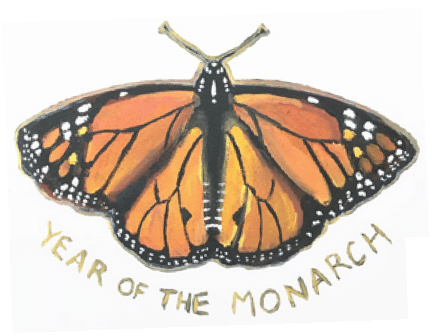In the night I dream of the Monarch butterflies. This is how I know spring is near. I dream of them huddled together in their winter sleeping grounds—in the oyamel fir forests of western Mexico, some in California along the Pacific coast, others in secret places—coloring the trees in living, fluttering, orange and black—“small pieces of sunlight.” Here, the butterflies have been resting in diapause, a hormonally-controlled state of dormancy that enables them to survive the winter—since the fall. But soon, usually in mid-March, the butterflies will rouse and, upon awakening, will mate and begin their long journey north, laying eggs along the way.

There will be danger along the way.
Though most animals will not eat monarch butterflies due to their bad taste, the eggs they leave behind on milkweed plants are vulnerable to ants, spiders, and wasps. The migrating butterflies may encounter storms or droughts that can decimate large numbers of monarchs. Scientists believe climate change is a very real threat to the monarch population. But perhaps the greatest threat to the monarch butterfly in recent years has been habitat destruction. The unbroken prairie full of native milkweed and other rich nectar sources that used to be common throughout the mid United States is mostly a thing of the past. New construction and large-scale farming using herbicides that wipe out native milkweeds have disrupted the monarchs’ habitat, making the journey north much more treacherous than it used to be.
That’s why the monarch butterfly needs our help. This is the time—in early spring—to plant native milkweeds and pollinator friendly plants they will need to sustain them on their journey. Especially native milkweeds, as we know this is the only plant the butterflies will lay their eggs on and the only plant the newly emerged monarch caterpillars will eat. Have you taken the pledge? Together, we can make a difference for the monarch butterfly population.
In late February, I start to dream about the Monarch butterflies. I begin to wonder if the milkweed I planted last fall will grow in time for their arrival. I start preparing new seeds for planting—giving them the time they need for cold stratification, increasing their chances for germination. An orange shard of light flutters through my dreams—the great-great-great-great grandchild of a monarch caterpillar who munched through my milkweed last year. How did they find me? How do they know the way back to their ancestral grounds? In the night, I dream about the monarch butterflies and I wonder …
Do they dream of me?
Do butterflies
dream? I googled
the question, sent
it to the ether
of the internet,
landing in a forum
for insect lovers.
The philosophy
guy said no, they don’t
have the “mental
machinery” needed
to dream. But, how
long have we known
that trees talk to
each other? That birds
navigate using stars
and the earth’s
magnetic field? bees
dance out directions
to the best nectar
sources? I can get lost
in the music of the
mysteries of nature
all we know
all we don’t know
we know nothing, really
Zhangzi dreamed
he was a butterfly
and when he awakened
the way he saw the world
was changed. Don’t we
all need such an
awakening? Do
butterflies dream?
And if they do, do
they dream of me?
—Laura Boggess
Photos and post by Laura Boggess, author of Mildred’s Garden, Waiting for Neruda’s Memoirs and serial novel The Honey Field. Photos used with permission.
- Year of the Monarch—A Visit to Craik-Patton House - September 18, 2024
- Year of the Monarch: Butterfly Dreams - March 20, 2024
- Year of the Monarch: Harvesting and Planting Milkweed Seeds - November 15, 2023


Megan Willome says
Love your poem, Laura.
I absolutely believe they dream.
Laura says
Me toooo! This tiny thought took me down some interesting rabbit holes, Megan. Funny how the more you read about some things, the less you know.
Dheepa R. Maturi says
Thank you for this beautiful essay and poem, Laura. I, too, believe that butterflies dream. Maybe there’s a shared dreamscape that all of us creatures share, where we can find one another!
Laura says
I love this thought of a shared dreamscape, Dheepa! Reminds me of Carl Jung’s ideas about the “collective unconscious.” I believe there is so much untapped mystery in the natural world and it’s a mistake to believe we know all the answers 😊. It sounds like you do too!
L.L. Barkat says
What a beautiful poem, Laura! 🙂
This is amazing: “All together it will take three to four generations of butterflies…” I did not know.
My seeds are sitting in the refrigerator, waiting for me to plant them soon. I don’t know if I’ll get any monarchs, but I want to create the possibility. That’s what I think we all can do. Create possibilities. Whether through planting or saving spaces or creating new monarch-friendly community spaces. I’m wondering what it would look like if every town across this great land created a little space for monarch dreams such as these…
Laura says
Wouldn’t it look amazing?? Let’s keep imagining it, ok? And we’ll keep spreading the word about how to help. ❤️
Michelle Ortega says
Your poem! And wow, I didn’t realize, or ever even consider, that butterflies arent’ alive for their whole migration and back. I think, if pressed, I’d have to say they fly to Mexico for the winter and fly home again in the summer…that seems ridiculous now that I type it here. How much I don’t know, on any given day. Thanks for the facts, the thoughts, and the encouragement to dream. 🙂